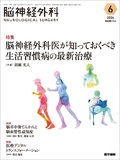Japanese
English
- 有料閲覧
- Abstract 文献概要
- 1ページ目 Look Inside
- 参考文献 Reference
Point
・脂質異常症の治療の原則は,一次予防としてまず生活習慣の改善,次に薬物療法を考慮し,二次予防として生活習慣の是正とともに薬物療法を考慮する.
・急性冠症候群,糖尿病,アテローム血栓性脳梗塞を合併する二次予防では,LDLコレステロール < 70mg/dLが目標となる.
・未治療時LDLコレステロール ≧ 180mg/dL,黄色腫,早期性冠動脈疾患の家族歴は家族性高コレステロール血症を疑い,専門医に紹介する.
・原疾患合併による続発性脂質異常症を疑う場合は,原疾患治療を優先し,内科医(専門医)に紹介する.
In patients without cardiovascular disease(primary prevention), the diagnosis of dyslipidemia is the initial step in lipid management. The 2022 guidelines for atherosclerotic disease prevention provide a validated clinical scoring tool to estimate the 10-year risk of atherosclerotic disease derived from the Hisayama study. For primary prevention, patients are classified into the categories of low(<2%), intermediate(2 to<10%)and high(≧10%)risk. Patients with diabetes mellitus, chronic kidney disease, or peripheral arterial disease are considered at high risk without calculating the risk score. Lifestyle intervention is initiated, followed by low-density lipoprotein cholesterol(LDL-C)-lowering therapy with statins aimed at the target levels. Secondary prevention of acute coronary syndrome, diabetes mellitus, and atherosclerotic brain infarction is associated with the highest risk of cardiovascular disease. High-intensity statin therapy is recommended as the first-line treatment in this group to achieve less than 70 mg/dL of LDL-C levels. The addition of ezetimibe is recommended first if LDL-C levels remain elevated with maximal statins. The addition of a Proprotein Convertase Subtilisin/Kexin type 9 inhibitor to strong statins is recommended for patients with coronary artery disease whose LDL-C levels remain elevated despite the administration of maximal LDL-C-lowering therapy. Secondary dyslipidemia should be managed using causative diseases or drugs. Patients with familial hypercholesterolemia should be referred to specialists.

Copyright © 2024, Igaku-Shoin Ltd. All rights reserved.


